Aliens (film)
Aliens is a 1986 American science fiction action film[9] written and directed by James Cameron, produced by Gale Anne Hurd and starring Sigourney Weaver. The second installment in the Alien franchise, it follows Ellen Ripley (Weaver) as she returns to the moon where her crew encountered the hostile Alien creature, this time accompanied by a unit of space marines. Additional roles are played by Carrie Henn, Michael Biehn, Paul Reiser, Lance Henriksen, Jenette Goldstein, William Hope, Al Matthews, and Bill Paxton.
| Aliens | |
|---|---|
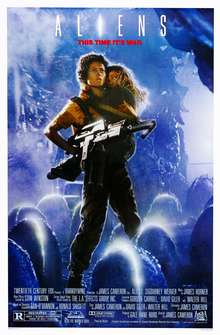 Theatrical release poster | |
| Directed by | James Cameron |
| Produced by | Gale Anne Hurd |
| Screenplay by | James Cameron |
| Story by |
|
| Starring | Sigourney Weaver |
| Music by | James Horner |
| Cinematography | Adrian Biddle |
| Edited by | Ray Lovejoy |
Production companies | |
| Distributed by | 20th Century Fox |
Release date |
|
Running time | 137 minutes[1] |
| Country | United States[1][2][3] |
| Language | English |
| Budget | $18 million[4][5] |
| Box office | $131.3–183.3 million[6][7] |
Gordon Carroll, David Giler, and Walter Hill of Brandywine Productions, who produced the first Alien (1979) and its later sequels, served as executive producers. They were immediately interested in a sequel to Alien, but the new management at 20th Century Fox postponed plans until 1983. Brandywine picked Cameron to write after reading his script for The Terminator (1984); when that film became a hit, Fox greenlit Aliens with Cameron as director and a budget of $18 million. It was filmed in England at Pinewood Studios and a decommissioned power plant in Acton, London.
Aliens was released on July 18, 1986, and grossed $180 million worldwide. It was nominated for seven Academy Awards, including a Best Actress nomination for Sigourney Weaver, winning Sound Effects Editing and Visual Effects. It won eight Saturn Awards (Best Science Fiction Film, Best Actress for Weaver, Best Supporting Actor for Paxton, Best Supporting Actress for Goldstein, and Best Direction and Best Writing for Cameron), and a Hugo Award for Best Dramatic Presentation. Empire magazine voted it the "Greatest Film Sequel of All Time". Aliens was the seventh-highest-grossing film of 1986 in North America. Alien 3 was released in 1992, with Weaver reprising her role as Ripley and Henriksen as Bishop.
Plot
For 57 years, Ellen Ripley has been in stasis in an escape shuttle after destroying her ship, the Nostromo, to escape a lethal alien creature that slaughtered her crew. She is rescued and debriefed by her employers at the Weyland-Yutani Corporation, but they are skeptical of her claims that her crew found alien eggs in a derelict ship on the exomoon LV-426, as it is now the site of the terraforming colony Hadleys Hope.
After contact is lost with the colony, Weyland-Yutani representative Carter Burke and Colonial Marine Lieutenant Gorman ask Ripley to accompany them to investigate. Still traumatized from her alien encounter, she agrees on the condition that they exterminate the creatures. Aboard the spaceship USS Sulaco, she is introduced to the Colonial Marines and the android Bishop.
A dropship delivers the expedition to the surface of LV-426, where they find the colony deserted. Inside, they find makeshift barricades and battle signs, but no bodies; two live facehuggers in containment tanks; and a traumatized young girl nicknamed Newt, the sole survivor. The crew locates the colonists grouped beneath the fusion-powered atmosphere processing station. They head to the location, descending into corridors covered in alien secretions.
At the center of the station, the marines find the colonists cocooned, serving as incubators for the creatures' offspring. The marines kill an infant alien after it bursts from a colonist's chest, rousing multiple adult aliens who ambush the marines, killing or capturing many of them. When the inexperienced Gorman panics, Ripley assumes command, taking control of their armored personnel carrier, and rams the nest to rescue Corporal Hicks, and Privates Hudson and Vasquez. Hicks orders the dropship to recover the survivors, but a stowaway alien kills the pilots, causing it to crash into the station. The remaining group barricades themselves inside the colony.
Ripley discovers that Burke had ordered the colonists to investigate the derelict spaceship containing the alien eggs, intending to become wealthy by recovering alien specimens for use as biological weapons. She threatens to expose him, but Bishop informs the group that the dropship crash damaged the power plant cooling system, and it will soon explode and destroy the colony. He volunteers to crawl through extensive piping conduits to reach the colony's transmitter and remotely pilot the Sulaco's remaining dropship to the surface.
Ripley and Newt fall asleep in the medical laboratory, awakening to find themselves locked in the room with the two facehuggers, which have been released from their tanks. Ripley triggers a fire alarm to alert the marines, who rescue them and kill the creatures. Ripley accuses Burke of releasing the facehuggers so that they would impregnate her and Newt, allowing him to smuggle the embryos past Earth's quarantine, and of planning to kill the rest of the marines so that no one could contradict his version of events. The power is suddenly cut, and aliens assault through the ceiling. In the ensuing firefight, Burke flees but is cornered by an alien and killed, while Hudson is captured after covering the others' retreat. Gorman and the injured Vasquez sacrifice themselves to stall the aliens; Hicks is injured, and Newt is captured.
Ripley and Hicks reach Bishop in the second dropship, but Ripley refuses to abandon Newt. The group travels to the processing station, allowing a heavily armed Ripley to enter the hive and rescue Newt. As they escape, the two encounter the alien queen in her egg chamber. When an egg begins to open, Ripley uses her flamethrower to destroy the eggs and the queen's ovipositor. Pursued by the enraged queen, Ripley and Newt reunite with Bishop and Hicks on the dropship. All four escape moments before the station explodes with the colony consumed by the nuclear blast.
On the Sulaco, the group is ambushed by the queen, who stowed away in the ship's landing gear. The queen tears Bishop in half and advances on Newt, but Ripley battles the creature using an exosuit cargo-loader and expels it through an airlock into space. Ripley, Newt, Hicks, and the critically damaged Bishop enter hypersleep for their return trip to Earth.
Cast
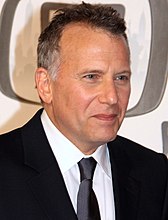
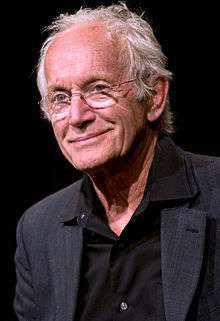
- Sigourney Weaver as Ellen Ripley: A Warrant officer and the sole survivor of an alien attack on her ship, the Nostromo
- Michael Biehn as Corporal Dwayne Hicks
- Paul Reiser as Carter J. Burke: A Weyland-Yutani Corporation representative
- Lance Henriksen as Bishop: An android serving aboard the Sulaco
- Carrie Henn as Rebecca "Newt" Jorden: A young girl living in a human colony on exomoon LV-426
- Bill Paxton as Private Hudson
- William Hope as Lieutenant Gorman: The Marines' inexperienced commanding officer
- Jenette Goldstein as Private Vasquez
- Al Matthews as Sergeant Apone: One of the Marines' commanding officers.
Also featured are Mark Rolston as Private Drake, Ricco Ross as Private Frost, Colette Hiller as Corporal Ferro, Daniel Kash as Private Spunkmeyer, Cynthia Dale Scott as Corporal Dietrich, the Marines' corpsman, Tip Tipping as Private Crowe, and Trevor Steedman as Private Wierzbowski. Paul Maxwell portrays Van Leuwen, the head of the review board that revokes Ripley's flight license, and Carl Toop portrays the aliens and alien queen.
Development
Conception
David Giler declared in 1979 Brandywine Productions were intent on "immediately making a sequel" to Alien, having the full support of 20th Century Fox president Alan Ladd Jr.. However, that year Ladd left amid Fox's transition to new owners Marc Rich and Marvin Davis, and the new studio management had no interest in the sequel.[10] Giler accused new president Norman Levy of being the one that held back the film's production; Levy would later declare that "It was a movie I wanted to make," but he felt another Alien would prove too costly. In the meantime, Giler and partners Walter Hill and Gordon Carroll sued Fox regarding the disbursement of the Alien profits. By the time the lawsuit was settled in 1983, Fox had new executives that got interested in continuing Alien.[11] Giler pitched the project to one of the executives as a cross between Hill's Southern Comfort and The Magnificent Seven.[10]
While the producers and development executive Larry Wilson sought a writer for Alien II, Wilson came across James Cameron's screenplay for The Terminator, and passed the script to Giler, feeling Cameron was right for the job.[11] Giler then approached Cameron, who was completing pre-production of The Terminator. A fan of the original Alien, Cameron was interested in crafting a sequel and entered a self-imposed seclusion to brainstorm a concept for Alien II.[12] After four days Cameron produced an initial 45-page treatment, although the Fox management put the film on hiatus, as some disliked the pitch, and they felt that Alien had not generated enough profit to warrant a sequel.[11][12] A scheduling conflict with actor Arnold Schwarzenegger caused filming of The Terminator to be delayed by nine months (as Schwarzenegger was filming Conan the Destroyer), allowing Cameron additional time to write a script for Aliens. While filming The Terminator, Cameron wrote 90 pages for Aliens, and although the script was not finished, Fox's new president Larry Gordon was impressed and told him that if The Terminator was a success, he would be able to direct Aliens.[10][11] Cameron even declared that he spent production of The Terminator thinking on which elements of that film could "make a good dry run" for the Alien sequel.[5]
Following the success of The Terminator, Cameron and producing partner Gale Anne Hurd were given approval to direct and produce the sequel to Alien, scheduled for a 1986 release. Cameron was enticed by the opportunity to create a new world and opted not to follow the same formula as Alien, but to create a worthy combat sequel focusing "more on terror, less on horror".[13] Sigourney Weaver, who played Ripley in Alien, had doubts about the project, but after meeting Cameron she expressed interest in revisiting her character. 20th Century Fox, however, refused to sign a contract with Weaver over a payment dispute and asked Cameron to write a story excluding Ripley.[10] He refused on the grounds that Fox had indicated that Weaver had signed on when he began writing the script. With Cameron's persistence, Fox signed the contract, and Weaver obtained a salary of $1 million plus a percentage of the profits[11] (equivalent to $2,400,000 in present-day terms).
Cameron drew inspiration for the Aliens story from the Vietnam War, a situation in which a technologically superior force was mired in a hostile foreign environment: "Their training and technology are inappropriate for the specifics, and that can be seen as analogous to the inability of superior American firepower to conquer the unseen enemy in Vietnam: a lot of firepower and very little wisdom, and it didn't work."[12][14] The attitude of the Colonial Marines was influenced by the Vietnam War; they are portrayed as cocky and confident of their inevitable victory, but when they find themselves facing a technologically inferior but more determined enemy, the outcome is not what they expect.[13] Cameron listed Robert A. Heinlein's novel Starship Troopers as a major influence that led to the incorporation of various themes and phrases, such as the terms "the drop" and "bug hunt" as well as the cargo-loader exoskeleton.[15]
Casting

Cameron opted to hire actors who had, or could imitate, American accents. After over 3,000 individuals in the United Kingdom were unsuccessfully auditioned, American actors were chosen instead, including three who had previously worked with Cameron on The Terminator: Lance Henriksen, Bill Paxton, and Michael Biehn. Actors who played Marines were asked to read Robert A. Heinlein's novel Starship Troopers and undergo military training, which included running, lifting weights, learning salutes, marches, deployments, and maneuvers, for two weeks. Cameron wanted the Marines to train together so that they would form bonds that would show on-screen. Sigourney Weaver, William Hope, and Paul Reiser were absent from training because of other obligations, but Cameron felt that this suited their characters as "outsiders" in the film.[16]
Weaver reprised her role from Alien. Biehn was hastily cast a week after filming had commenced, and thus was not present for the military training.[16] James Remar was originally cast as Hicks but left the project over creative differences with Cameron.[17] In an interview on episode #128 of the Sidebar podcast, Remar stated that he was fired after he was arrested for drug possession. Only a few shots of him remain in the film, such as when the team first enters the alien hive, because those sequences were too expensive to re-shoot; only his back is seen.[18]
According to the casting director, Newt was the most difficult role to cast: school children were auditioned, but many of them had acted in commercials and were accustomed to smiling after saying their lines. Henn, from Atwater, California,[19] was chosen out of 500 children for the role, although she had no previous acting experience.[16][13] She received a Saturn Award for Best Performance by a Younger Actor,[20] but chose not to pursue an acting career, and became a teacher.[21] Matthews attributed his casting to his military experience.
Filming
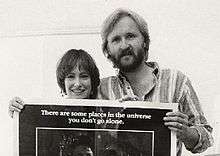
Aliens was filmed over ten months on a budget of $18 million at Pinewood Studios in England.[12] Cameron, bound by a low budget and a deadline, found it difficult to adjust to what Paxton called the "indentured" working practices of the British crew, such as the tea breaks that brought production to a halt. Many of the crew had worked on Alien and were fiercely loyal to Ridley Scott, and they believed the 31-year-old Cameron was too young and inexperienced to direct. In response, he arranged a screening of The Terminator, which had not yet been released in the UK, but many of the crew did not attend.[22] They also mocked producer Gale Anne Hurd, insisting that she was only receiving the producer credit because she was married to Cameron. Cameron clashed with the original director of photography Dick Bush when Bush started production saying the schedule couldn't be met and when he insisted on lighting the alien nest set brightly. Cameron insisted on a dark, foreboding nest, relying on the lights from the Marines' armor. After Bush was fired, the crew walked out. Hurd managed to coax the team back to work, and Adrian Biddle was hired as Bush's replacement.[22]
Some scenes of the alien nest were shot at the decommissioned Acton Lane Power Station in Acton, London. The crew thought it was a perfect place to film because of its grilled walkways and numerous corridors, but had to spend money to remove asbestos from the station.[23] The Atmosphere Processor set was not dismantled after filming, and was reused in 1989 as the Axis Chemicals set for Batman (1989).[24]
Music
Music composer James Horner felt he was not given enough time to create a musical score. Horner arrived in England and expected the film to be completed and to write the score in six weeks, which he thought was a sufficient amount of time. Horner, however, discovered that filming and editing were still taking place, and he was unable to view the film. He visited the sets and editing rooms for three weeks and found that editor Ray Lovejoy was barely keeping up with the workload for reasons of time restrictions. Horner believed Cameron was preoccupied with sound effects, citing that Cameron spent two days with the sound engineer creating the sounds for the pulse rifles. He also complained that he was given an outdated recording studio; the score was recorded with the London Symphony Orchestra at Abbey Road Studios, a then-30-year-old studio that was barely able to patch in synthesizers or use the electronic equipment that Horner required.[25]
Six weeks from theatrical release, no dubbing had taken place and the score had not been written as Horner was unable to view the completed film. The final cue for the scene in which Ripley battles the alien queen was written overnight. Cameron completely reworked the scene, leaving Horner to rewrite the music. As Gale Hurd did not have much music production experience, she and Cameron denied Horner's request to push the film back four weeks so he could finish the score. Horner felt that, given more time, he could get the score to 100% of his satisfaction rather than the 80% he estimated he had been able to achieve. The score was recorded in roughly four days.[25] Despite his troubles, Horner received an Academy Award nomination (his first) for Best Original Score.
Horner stated that tensions between himself and Cameron were so high during post-production that he assumed they would never work together again. Horner believed that Cameron's film schedules were too short and stressful. The two parted ways until 1997 when Cameron, impressed with Horner's score for Braveheart, asked him to compose the score for Titanic.[25]
Design

Early concept art was created by Syd Mead, who had previously worked on Blade Runner, 2010, and Tron. One of the original designs for the spaceship Sulaco was spherical, but it was redesigned as the ship would be out of frame due to the film's aspect ratio. Cameron showed Mead his own concept art, and the final result was described as "rocket gun that carries stuff". Concept artists were asked to incorporate subliminal acknowledgments to the Vietnam War, which included designing the dropship as a combination of an F-4 Phantom II and AH-1 Cobra.[23]
_APC.jpg)
British Airways was re-equipping several of its aircraft tug tractors, and the crew managed to purchase a 635 hp Hunslet ATT 77[26] tug to use as the armored personnel carrier. It initially weighed 70 short tons (64,000 kg), and although the crew removed 35 short tons (32,000 kg) of lead ballast, the power station floor had to be reinforced to support the weight. The crew used many "junk" items in the set designs, such as Ripley's toilet, which came from a Boeing 707. Lockers, helicopter engines, and vending machines were used as set elements in the opening hypersleep scene. Production designer Peter Lamont was asked to reduce the cost of several scenes, including the not-yet-filmed Colonial Marine hypersleep sequence. Gale Hurd wanted to cut the scene altogether, but Lamont and Cameron felt it was important to the sequence of the film. To save on cost, only four hypersleep chambers were created, and a mirror was used to create the illusion that there were twelve in the scene. Instead of using hydraulics, the chambers were opened and closed by wires operated by puppeteers.[23]
Weapons used by the Colonial Marines were based on fully functional weapons. British armorers used guns they found to be the most reliable when firing blanks and those which looked futuristic. The 'pulse rifles' were created from a Thompson SMG, with an attached forend of a Franchi SPAS-12 shotgun and a Remington 12-gauge Model 870P receiver with barrel. The 'smart guns' carried by Vasquez and Drake were based on the German MG 42 machine gun and were maneuvered with Steadicam-like harnesses created using old motorcycle parts. The crew found flamethrowers the most difficult weapon to create and use, as they were the heaviest and most dangerous.[27]
Aside from the alien queen, designed by Cameron himself, the aliens were inspired by H. R. Giger's designs for the original.[28] The only change was removing the translucent dome that gave the creature's head its sleek shape in Alien, exposing the ridged, spined cranium beneath. Cameron felt the dome was too fragile for the practical effects,[29] and also felt that the cranium design was more visually interesting without it.[13]
_-_Alien_queen.jpg)
Visual effects
Brothers Robert and Dennis Skotak were hired to supervise the visual effects, having previously worked with Cameron on several Roger Corman movies. Two stages were used to construct the colony on LV-426, using miniature models that were, on average, six feet tall and three feet wide.[30] Filming the miniatures was difficult because of the weather; the wind would blow over the props; however, it proved helpful to give the effect of weather on the planet. Cameron used these miniatures and several effects to make scenes look larger than they really were, including rear projection, mirrors, beam splitters, camera splits and foreground miniatures. Due to budget limits, Cameron said he had to pay for the robotic arm used to cut into Ripley's shuttle in the opening scene.[30][31] Practical effects supervisor John Richardson (who won a special effects Oscar for his part in the film) declared his biggest challenge was creating the forklift power-loader exoskeletons, which required only three months of work and had Cameron complaining about visual details during construction. The model could not stand on its own, requiring either wires dangling from the shoulders or a pole through the back attached to a crane. While Sigourney Weaver was inside the power loader model, a stunt man standing behind it would move the arms and legs.[28]
The alien suits were made more flexible and durable than the ones used in Alien to expand on the creatures' movements and allow them to crawl and jump. Dancers, gymnasts, and stunt men were hired to portray the aliens. Various 8-foot-tall (2.4 m) mannequins also were created to make aliens that stood in inhuman poses, and could have their bodies exploded to simulate gunshot wounds. Stan Winston's team created fully articulated facehuggers that could move their fingers; these were moved by wires hidden on the scenery or the actors' clothing. The one that walked towards Ripley had a mechanism akin to a pull toy, with pulleys that moved the fingers, and its jump combined three models shot separately: the walking facehugger, a stationary model dangling on a table leg, and another model being pulled towards the camera.[29]
According to production staff, scenes involving the alien queen were the most difficult to film. A life-sized mockup was created by Stan Winston's company in the United States to see how it would operate. Once the testing was complete, the crew working on the queen flew to England and began work creating the final version. Standing at 14 feet (4.3 m) tall, it was operated using a mixture of puppeteers, control rods, hydraulics, cables, and a crane above to support it. Two puppeteers were inside the suit operating its arms, and 16 were required to move it. All sequences involving the full-size queen were filmed in-camera with no post-production manipulation.[30] Additionally, a miniature alien queen was used for certain shots.[32]
Release
Box office
Eagerly anticipated by fans following the success of Alien,[33] Aliens was released in North America on July 18, 1986, and August 29 in the United Kingdom. In North America, the film opened in 1,437 theaters with an average opening gross of $6,995 and a weekend gross of $10,052,042. It was #1 at the North American box office for four consecutive weeks, grossing $85,160,248. Aliens was the seventh-highest-grossing film of 1986 in North America.[34] The film's worldwide total gross has been stated as high as $180 million, making Aliens one of the highest-grossing R-rated films at the time.[35] In 1992, Fox noted the worldwide gross was $157 million.[36]
Critical reception
Aliens received universal acclaim. Test and pre-screenings were unable to take place due to the film not being completed until its week of release.[37] Once it was released in cinemas, critical reaction was very positive. Audiences polled by CinemaScore gave the film an average grade of "A" on an A+ to F scale.[38]
Critic Roger Ebert gave the film 3.5 stars out of 4, and called it "painfully and unremittingly intense" and a "superb example of filmmaking craft". He also stated that "when I walked out of the theater, there were knots in my stomach from the film's roller-coaster ride of violence."[39] Walter Goodman of The New York Times said it was a "flaming, flashing, crashing, crackling blow-'em-up show that keeps you popping from your seat despite your better instincts and the basically conventional scare tactics."[40] Time magazine featured the film on the cover of its issue of July 28, 1986, calling it the "summer's scariest movie". Time reviewer Richard Schickel declared the film "a sequel that exceeds its predecessor in the reach of its appeal while giving Weaver new emotional dimensions to explore."[12] The selection of Aliens for a Time cover was attributed to the successful reception of the film,[41][42] as well as its novel example of a science-fiction action heroine.[43] Echoing Time's assessment, Dave Kehr of the Chicago Reader called the film "one sequel that surpasses the original".[44] On the negative side, Gene Siskel described Aliens as "one extremely violent, protracted attack on the senses" and that "toward the end, the film resorts to placing a young girl in jeopardy in a pathetic attempt to pander to who knows what audience. Some people have praised the technical excellence of Aliens. Well, the Eiffel Tower is technically impressive, but I wouldn't want to watch it fall apart on people for two hours."[45]
Accolades
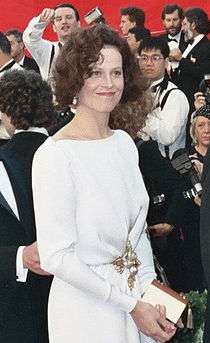
Aliens was nominated for seven Academy Awards including Best Actress, Best Original Score, Best Sound, Best Film Editing, and Best Art Direction. It won two awards for Sound Effects Editing and Visual Effects. Sigourney Weaver received her first Academy Award nomination for Best Actress and although she did not win, it was considered a landmark nomination for an actress to be considered for a science-fiction/horror film, a genre which previously was given little recognition.[13][37][46]
Aliens received four BAFTA award nominations and won in the category of Visual Effects.[47] It won eight Saturn Awards in the film categories of actress (Sigourney Weaver), supporting actor (Bill Paxton), supporting actress (Jenette Goldstein), performance by a younger actor (Carrie Henn), direction (James Cameron), writing (James Cameron), special effects (Stan Winston and the L.A. Effects Group), and science-fiction film.[20]
Time magazine named Aliens in its Best of '86 list calling it a "technically awesome blend of the horror, sci-fi and service-comedy genres."[48] In 2007, Entertainment Weekly named Aliens as the second-best action movie of all time behind Die Hard.[49] In a Rotten Tomatoes analysis of the top 100 science-fiction films, Aliens ranks tenth among the best-reviewed films of the genre.[50] In 2004, Aliens was ranked 35th on Bravo's "100 Scariest Movie Moments" for the scene in which Ripley and Newt are attacked by facehuggers; the original Alien was ranked second for the chestburster scene.[51] IGN ranked it third in its "Top 25 Action Films of All Time", stating that "there won't be an Alien movie as scary—or exciting—as this one made ever again."[52] Empire voted it the 'Greatest Film Sequel Of All Time'.[53]
The film is also recognized by American Film Institute in the 2003 list AFI's 100 Years...100 Heroes & Villains: Ellen Ripley as the #8 hero.[54]
Post-release
Home media
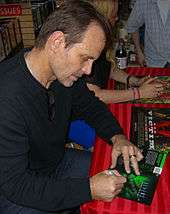
Aliens was first released on VHS in 1987, finishing as the tenth-best-selling title of the year.[55] A "special edition" of Aliens that restored 17 minutes of deleted footage was released in the UK on VHS on April 5, 1990[56] and in the US on LaserDisc in 1991 and on VHS the following year. These additions include a segment showing Newt's family first encountering the derelict spacecraft on LV-426, Ripley's learning that her daughter died during the years she was in hypersleep, a scene in the operations building in which the Marines use sentry guns against the aliens, and several extended dialogue scenes between Ripley and the Marines.[13] These scenes had been deleted from the original theatrical release as 20th Century Fox representatives thought the film was showing "too much nothing" and spent an unnecessary amount of time building suspense.[13]
Most of the special edition's footage was first seen when the film made its broadcast television debut on CBS in 1989, but two additional sequences concerning Burke's transmission to the colony about the derelict, and the Jorden family's subsequent discovery of the same, were added to the initial LaserDisc release. According to Cameron, the visual effects for the scene were incomplete, so he went back to the Skotak brothers and had them finish the sequences. All currently available versions of the special edition contain these scenes.
The special edition was released as part of The Alien Legacy 20th Anniversary Edition DVD box set in 1999 along with Alien, Alien 3, and Alien Resurrection. Both the theatrical version and the special edition were released again in 2003 as part of the Alien Quadrilogy DVD box set along with similar versions of Alien, Alien 3, and Alien Resurrection. A separate two-disc "special collector's edition" DVD of Aliens was released on January 6, 2004, containing the same material as the two Aliens discs in the Quadrilogy set.[57] Additional content in these versions included an audio commentary for the special edition featuring director James Cameron, producer Gale Hurd, special effects artists and crew members. The second disc included special features relating to pre-production, production, and post-production.[58] The film was first made available on Blu-ray in the 2010 box set Alien Anthology,[59] before receiving a stand-alone release the following year.[60] Fox released the 30th-anniversary Blu-ray of the movie on September 13, 2016.[61]
Interpretation and analysis
Philosopher Stephen Mulhall has remarked that the four Alien films represent an artistic rendering of the difficulties faced by the woman's "voice" to have itself heard in a masculinist society because Ripley continually encounters males who try to silence her and to force her to submit to their desires. Mulhall sees this depicted in several events in Aliens, particularly the inquest scene in which Ripley's explanation for the deaths and destruction of the Nostromo as well as her attempts to warn the board members of the Alien danger are met with officious disdain. However, Mulhall believes that Ripley's relationship with Hicks illustrates that Aliens "is devoted ... to the possibility of modes of masculinity that seek not to stifle but rather to accommodate the female voice, and modes of femininity that can acknowledge and incorporate something more or other of masculinity than our worst nightmares of it."[62]
Several movie academics, including Barbara Creed, have remarked on the color and lighting symbolism in the Alien franchise, which offsets white, strongly lit environments (spaceships, corporate offices) against darker, dirtier, "corrupted" settings (derelict alien ship, abandoned industrial facilities). These black touches contrast or even attempt to take over the purity of the white elements.[63] Others, such as Kile M. Ortigo of Emory University, agree with this interpretation and point to the Sulaco with its "sterilized, white interior".[64]
While some claim that the shape of the Sulaco was based on a submarine,[65] the design has most often been described as a "gun in space" resembling the rifles used in the movie.[66] Author Roz Kaveney called the opening shot of the ship traveling through space "fetishistic" and "shark-like", "an image of brutal strength and ingenious efficiency"—while the militarized interior of the Sulaco (designed by Ron Cobb) is contrasted to the organic interior of the Nostromo in the first movie (also designed by Cobb).[67] David McIntee noted the homage the scene pays to the opening tour through the Nostromo in Alien.[68]
Roger Luckhurst in his 2014 book on the original Alien film, compared its underlying worldview to that of Aliens stating, "Even if Alien was a piece of leftist science fiction, the core of (its) myth could be inflected the other way. James Cameron's Aliens would be a defiantly Reaganite version of the story—pumped, militarized, libertarian and driven by a staunch defense of the nuclear family."[69]
The android character Bishop has been the subject of literary and philosophical analysis as a high-profile fictional android conforming to science-fiction author Isaac Asimov's Three Laws of Robotics and as a model of a compliant, potentially self-aware machine.[70] His portrayal has been studied by writers for the University of Texas Press for its implications relating to how humans deal with the presence of an "Other",[71] as Ripley treats them with fear and suspicion after the android Ash tried to kill her in the original Alien movie, and a form of "hi-tech racism and android apartheid" is present throughout the series.[72] This is seen as part of a larger trend of technophobia in films before the 1990s, with Bishop's role being particularly significant as he doubly proves his worth at the end of the film, thus confounding Ripley's expectations.[73]
Cultural impact
Lasting reception
The film has remained critically acclaimed over the years. In a 2000 review, film critic James Berardinelli said "When it comes to the logical marriage of action, adventure, and science fiction, few films are as effective or accomplished as Aliens."[74] Austin Chronicle contributor Marjorie Baumgarten labeled the film in 2002 as "a non-stop action fest."[75] In 2016, James Charisma of Playboy ranked the film #6 on a list of "15 Sequels That Are Way Better Than the Originals".[76]
Aliens holds a 97% approval rating on Rotten Tomatoes based on 75 reviews, and an average rating of 9.01/10. The site's critical consensus reads, "While Alien was a marvel of slow-building, atmospheric tension, Aliens packs a much more visceral punch, and features a typically strong performance from Sigourney Weaver."[77] It also holds a score of 84 out of 100 based on 22 critics on Metacritic, indicating "universal acclaim".[78] Aliens was also featured in Empire Magazine's 500 Greatest Movies of All Time poll at #30 in 2008, in Empire's 301 Greatest Films of All Time poll at #19 in 2014 and in Empire's recent The 100 Greatest Movies of All Time poll at #15.
Merchandise
In 2013, National Entertainment Collectibles Association (NECA) released the first wave of highly detailed human and alien action figures from the respective film. NECA's Reel Toys worked directly with actors from the Alien franchise to release realistic figures based on select characters they portrayed in the films. NECA has released seven-inch figures based on characters such as Corporal Hicks, Private Hudson, and Bishop. During winter 2014, it was announced there would be multiple figures of Ripley, Sigourney Weaver's character from the Alien films. NECA worked directly with Weaver to develop these action figures, which are the first to feature her likeness.[79]
Three pinball adaptation of Aliens were also released, with two virtual and one physical. The first pinball adaptation of the film was one of four virtual tables in the 1999 computer game Sci-Fi Pinball, with the other three based on the first two Predator films, Buffy the Vampire Slayer and The Fly.[80] On April 26, 2016 Zen Studios released the Aliens vs. Pinball add-on pack for Zen Pinball 2, Pinball FX 2 and Pinball FX 3, which contained a digital pinball adaptation of the film featuring 3-D animated figures of Ripley and the Xenomorph Queen and omitting the film's graphic violence and strong profanity.[81] Nearly a year later, the short-lived Heighway Pinball developed and released a physical pinball adaptation of the first two films of the Alien franchise.[82][83][84][85]
Sequel
A sequel, Alien 3, was released in 1992.
See also
References
- "Aliens". American Film Institute. Archived from the original on September 5, 2015. Retrieved October 23, 2015.
- "Aliens". LUMIERE. Archived from the original on January 5, 2016. Retrieved October 23, 2015.
- "Aliens". Swedish Film Database. Archived from the original on November 11, 2017. Retrieved November 11, 2017.
- Kjolseth, Pablo. "Aliens". Turner Classic Movies. Retrieved December 24, 2014.
- Matthews, Jack (July 11, 1986). "ALIENS INTO SCARY SPACE ONCE MORE". Los Angeles Times. Retrieved May 13, 2020.
- "Aliens - Box Office Data, DVD and Blu-ray Sales, Movie News, Cast and Crew Information". The Numbers. Retrieved December 15, 2014.
- "Aliens (1986)". Box Office Mojo. Retrieved December 15, 2008.
- Nawara, Jason (July 24, 2016). "James Cameron Knows Why 'Aliens' Has Been Loved For 30 Years". Uproxx. Retrieved July 28, 2018.
- [1][8]
- 57 Years Later - Continuing the story, Superior Firepower. Alien Anthology Blu-Ray.
- Friendly, David T. (July 24, 1986). "'ALIENS': A BATTLE-SCARRED TREK INTO ORBIT". Los Angeles Times. Retrieved August 18, 2014.
- Schickel, Richard (July 28, 1986). "Cinema: Help! They're Back!". Time. Retrieved July 16, 2007.
- Aliens: Special Edition audio commentary
- Shay, Don. "Aliens." Cinefex. Vol 27. August 1986.
- Cameron, James (2001). "Mothers With Guns". In Sammon, Paul M. (ed.). Aliens: The Illustrated Screenplay. Orion. pp. 10–20. ISBN 0752831933.
- Preparing for Battle - Casting and characterization, Superior Firepower
- "Latest Movie Features - Best & Worst Lists - Spoilers - Empire".
- "Archived copy". Archived from the original on April 2, 2015. Retrieved March 26, 2015.CS1 maint: archived copy as title (link)
- What ever happened to....: Carrie Henn who played Newt in the movie Aliens Retrieved 2016-11-27.
- "Saturn Award Winners". Saturn Awards. Archived from the original on February 7, 2008. Retrieved March 3, 2008.
- Steptoe, Sonja (August 13, 2001). "Down to Earth". People. New York City: Meredith Corporation. Retrieved November 24, 2013.
- This Time It's War - Pinewood Studios, 1985, Superior Firepower
- Building Better Worlds - From concept to construction, Superior Firepower
- Kemble, Gary (December 2, 2005). "Movie Minutiae: Aliens". ABC. Archived from the original on December 22, 2007. Retrieved March 2, 2008.
- The Final Countdown – Music, editing and sound, Superior Firepower
- "england - stand - tel - 1970 - 1142 - Flight Archive".
- The Risk Always Lives - Weapons and action, Superior Firepower
- "Beauty and the Bitch: Power Loader vs. Alien Queen" Featurette. Alien Quadrilogy DVD Set, Disc 4 - Aliens Supplemental. 2003.
- "Bug Hunt: Creature Design" Featurette. Alien Quadrilogy DVD Set, Disc 4 - Aliens Supplemental. 2003.
- The Power of Real Tech - Visual effects, Superior Firepower
- "36 Things We Learned From the 'Aliens' Commentary" Film School Rejects
- Prop Archives website listing for miniature alien queen. Archived April 2, 2015, at the Wayback Machine
- Cosford, Bill. Let 'Aliens' Invade Your Peace of Mind. The Miami Herald, July 18, 1986, pg. 1D.
- "Aliens (1986)". Box Office Mojo. IMDb.com, Inc. Retrieved December 7, 2018.
- "Titanic Production Notes" (Press release). 20th Century Fox, Paramount Pictures. 1997. Archived from the original on September 8, 2014. Retrieved September 8, 2014.
- "The Baddest of Them All (Fox advertisement)". Daily Variety. October 6, 1992. p. 8.
- Aliens Unleashed - Reaction to the film, Superior Firepower
- "CinemaScore". cinemascore.com.
- Ebert, Roger (July 18, 1986). "Aliens (review)". Chicago Sun-Times.
- Goodman, Walter (July 18, 1986). "Movie Review: Aliens (1986) - Film: Sigourney Weaver in 'Aliens'". The New York Times.
- Kjolseth, Pablo. "Aliens - Special Event Archives". Turner Classic Movies. Retrieved September 16, 2008.
- Stuever, Hank. (1997-11-28) Ripley knows best - Men in 'Alien' films just don't get it. Austin American-Statesman, p. E1
- Desjardins, David (March 10, 2007). "Movie Review: 300 (Aliens)". Blogcritics magazine. Archived from the original on October 6, 2008. Retrieved September 16, 2008.
- Kehr, Dave. "Aliens (review)". Chicago Reader.
- Siskel, Gene (August 8, 1986). "Flick Of Week: 'Vagabond' One Of Finest Films In Years". Chicago Tribune. Retrieved February 1, 2014.
- Career of living dangerously: Sigourney Weaver ready for next risk. New York Daily News, Knight Ridder/Tribune News Service. March 21, 2001.
- "Film nominations 1986". British Academy of Film and Television Arts. Archived from the original on February 28, 2008. Retrieved March 3, 2008.
- "Best of '86". Time magazine. January 5, 1987. Retrieved March 3, 2008.
- Bernardin, Marc. "The 25 Greatest Action Films Ever!". Entertainment Weekly. Archived from the original on June 21, 2007. Retrieved July 16, 2007.
- "100 Best-Reviewed Sci-Fi Movies". Rotten Tomatoes. Archived from the original on July 15, 2007. Retrieved July 16, 2007.
- "The 100 Scariest Movie Moments". Bravo. Archived from the original on October 30, 2007. Retrieved May 29, 2010. (via Internet Archive)
- "The Top 25 Action Films of All-Time". IGN. Archived from the original on April 4, 2008. Retrieved March 9, 2008.
- "The 50 Greatest Sequels".
- "AFI's 100 Years...100 Heroes & Villains" (PDF). American Film Institute. Archived from the original (PDF) on March 13, 2011. Retrieved August 20, 2016.
- Klain, Jane, ed. (1990). 1989 International Television and Video Almanac. Quigley. p. 25. ISBN 0900610409.
- "'Aliens' Could Set Scene for 'Special Editions' Genre". Variety. March 28, 1990. p. 40.
- "Aliens (Two-Disc Collector's Edition)". Retrieved March 3, 2008.
- Patrizio, Andy. "Aliens - Collector's Widescreen Edition". IGN. Retrieved March 9, 2008.
- Shaffer, R.L. (October 27, 2010). "Alien Anthology Blu-Ray Review". IGN. Retrieved March 9, 2014.
- Shaffer, R.L. (May 10, 2011). "ALIENS, NO STRINGS, DIGIBOOKS AND TOP GUN". IGN. Retrieved March 9, 2014.
- Breznican, Anthony (July 6, 2016). "Aliens reunion planned for Comic-Con — exclusive". Entertainment Weekly.
- Stephen Mulhall, "In Space, No-One Can Hear You Scream: Acknowledging the Human Voice in the Alien Universe," in Film as Philosophy: Essays on Cinema After Wittgenstein and Cavell, editors Read, Rupert and Jerry Goodenough; Palgrave Macmillan, 2005, p. 60
- Alien and the Monstrous-Feminine – Creed, Barbara; from Alien Zone: Cultural Theory and Contemporary Science Fiction Cinema, Editor Kuhn, Annette; Verso, 1990, Page 129
- Ripley and Alien Archived August 25, 2012, at the Wayback Machine – Ortigo, Kile M. in "I'm a Stranger Here Myself": Forced Individuation in Alien Resurrection, Department of Psychology, Emory University, Georgia, United States. Accessed 2008-05-20.
- Alien[s] (from the 'starshipmodeler.com' website. Accessed 2008-05-20.)
- Syd Mead's "Sulaco" ship from Aliens just a big gun Boing Boing Accessed 2008-05-18.
- Alien to The Matrix: Reading Science Fiction Film – Kaveney, Roz; I.B. Tauris, 2005, Page 159
- Beautiful Monsters: The Unofficial and Unauthorized Guide to the Alien and Predator Movies – McIntee, David; Telos Publishing, 2005
- Luckhurst, Roger (2014). BFI Classics: Alien. Palgrave MacMillan. Page 46.
- Buttazzo, G (May 2000). "Can a Machine Ever Become Self-Aware?". In R. Aurich, W. Jacobsen and G. Jatho (ed.). Artificial Humans, an historical retrospective of the Berlin International Film Festival 2000. Goethe Institute, Los Angeles. pp. 45–49.
- Nishime, LeiLani (Winter 2005). "The Mulatto Cyborg: Imagining a Multiracial Future" (PDF). Cinema Journal. University of Texas Press. 44 (2): 34–49. doi:10.1353/cj.2005.0011. Archived from the original (PDF) on April 7, 2020.
- Kozlovic, Anton Karl (Spring 2004). "HAL-o-phobia: Computer Horror in the Pre-1990 Popular Cinema". Sincronía.
- Kozlovic, Anton Karl (September 2003). "Technophobic themes in pre-1990 computer films". Science as Culture. 12 (3): 341–373. doi:10.1080/09505430309008.
- Berardinelli, James (2000). "Aliens (review)". Reelviews.net. Retrieved April 16, 2008.
- Baumgarten, Marjorie (June 7, 2002). "Aliens (review)". Austin Chronicle.
- Charisma, James (March 15, 2016). "Revenge of the Movie: 15 Sequels That Are Way Better Than The Originals". Playboy. Archived from the original on July 26, 2016. Retrieved July 19, 2016.
- "Aliens (1986)". Rotten Tomatoes. Fandango. Retrieved August 9, 2020.
- "Aliens Reviews". Metacritic. CBS Interactive. Retrieved December 7, 2018.
- Stinsman, John (December 14, 2012). "Stinny's Toy & Action Figure News Network: Toy News for 12/12/2012 - NECA - Aliens - Series 1 - Hudson, Hicks & Alien Warrior".
- Fenlon, Wes. "Even naked Jeff Goldblum can't save this 1999 pinball game I bought for $1". PCGamer. Retrieved November 21, 2019.
- "Pinball FX2™". www.aliensvspinball.com. Archived from the original on March 17, 2018. Retrieved March 22, 2018.
- "Heighway Pinball's Alien Pinball Machine Unveiled". arcadeheroes.com. October 8, 2016. Retrieved January 7, 2017.
- "Heighway Pinball's Alien – update - Pavlov Pinball". pavlovpinball.com. Retrieved January 7, 2017.
- "Gerald Opens New Pinball Production Line in South Wales". geraldjones.co.uk. Archived from the original on January 6, 2017. Retrieved January 7, 2017.
- "News : Alien Pinball Machine Update : Serious Fun". wordpress.com. April 28, 2016. Retrieved January 7, 2017.
Sources
- Superior Firepower: The Making of Aliens, Alien Quadrilogy – Disc 3, 2003, 20th Century Fox
Further reading
- Alien Woman: The Making of Lt. Ellen Ripley (by Ximena Gallardo and Jason Smith, Continuum, 272 pages, 2004, ISBN 0-8264-1910-0)
- The Complete Aliens Companion (by Paul Sammon, Harper Prism, 1998, ISBN 0-06-105385-6)
- Beautiful Monsters: The Unofficial and Unauthorised Guide to the Alien and Predator Films (by David A. McIntee, Telos, 272 pages, 2005, ISBN 1-903889-94-4)
External links
| Wikimedia Commons has media related to Aliens. |
| Wikiquote has quotations related to: Aliens |